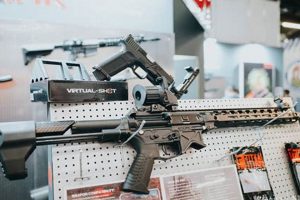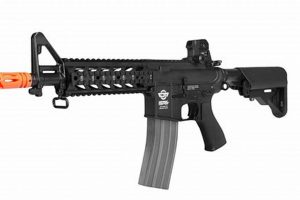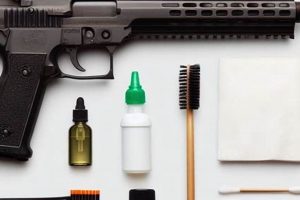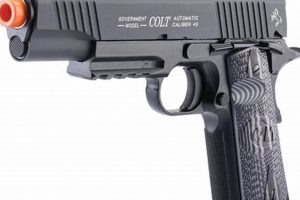The process of eliminating a coating of color from a simulated firearm replica requires careful consideration to avoid damaging the underlying material. Techniques employed must be selected based on the type of paint applied and the composition of the replicas exterior. Improper methods can lead to cosmetic flaws or, in extreme cases, structural weakening. For example, using harsh chemical solvents on plastic components could cause melting or discoloration.
Altering the aesthetic of an airsoft replica can serve various purposes, including achieving a more authentic appearance for historical reenactments, customizing the equipment to match a specific team uniform, or restoring a previously modified replica to its original condition. Furthermore, a well-executed alteration can increase the resale value of the equipment by allowing the owner to present a more desirable finish to potential buyers. Historically, modification of such replicas has been a common practice among enthusiasts seeking to personalize their gear.
Therefore, a structured approach is crucial. This necessitates assessing the replica’s material, identifying the paint type, and selecting the appropriate removal technique. Subsequent sections will detail several methods, ranging from manual abrasion to chemical treatments, outlining the pros and cons of each and providing guidance on their safe and effective application.
Tips for Removing Paint from Airsoft Replicas
Effective paint removal from airsoft replicas hinges on methodical execution and appropriate material selection. The following tips provide guidance for achieving optimal results while minimizing the risk of damage.
Tip 1: Identify the Replica Material: Prior to commencing any removal process, determine whether the replica is constructed from plastic, metal, or a combination thereof. Different materials react differently to solvents and abrasives. Metal components generally withstand harsher treatments than plastic.
Tip 2: Ascertain the Paint Type: Understanding whether the paint is acrylic, enamel, or a specialized coating is critical. Certain solvents are more effective on specific paint types. Testing a small, inconspicuous area first is advisable to gauge the solvent’s impact.
Tip 3: Prioritize Gentle Methods: Begin with the least aggressive removal techniques, such as warm soapy water and a soft brush. Incremental increases in aggressiveness should only be employed if initial attempts prove insufficient. This minimizes the risk of inadvertently damaging the replica.
Tip 4: Employ Specialized Paint Removers with Caution: Commercial paint removers designed for plastics or metals can be effective, but they often contain strong chemicals. Always wear appropriate personal protective equipment (PPE), including gloves and eye protection, and work in a well-ventilated area. Strictly adhere to the manufacturer’s instructions.
Tip 5: Consider Mechanical Abrasion as a Last Resort: Sanding or scraping should only be considered when chemical methods fail. Use fine-grit sandpaper (e.g., 600 grit or higher) and apply minimal pressure. Excessive force can create scratches or gouges on the replica’s surface.
Tip 6: Disassemble the Replica When Possible: Removing external components, such as magazines, sights, and stocks, simplifies the removal process and reduces the likelihood of damaging sensitive internal mechanisms. Consult the replica’s manual for disassembly instructions.
Tip 7: Thoroughly Clean After Removal: Once the paint has been removed, clean the replica thoroughly with a mild detergent and water to eliminate any residual chemicals or abrasive particles. Allow the replica to dry completely before reassembling.
By adhering to these guidelines, the process can be executed safely and effectively, preserving the integrity of the airsoft replica.
With these techniques understood, the article will now address specific removal methodologies in greater detail.
1. Material Compatibility
Material compatibility is paramount when undertaking any coating removal process on airsoft devices. The diverse range of materials used in their construction, including various plastics, alloys, and composites, necessitates careful consideration of cleaning agents and methods to prevent damage or degradation. Selecting an incompatible substance can lead to structural weakening, cosmetic flaws, or complete component failure.
- Plastic Degradation
Certain solvents, particularly those containing acetone or strong ketones, can aggressively dissolve or weaken various plastics commonly used in airsoft construction, such as ABS or polycarbonate. This can manifest as surface crazing, softening, or complete disintegration of the affected area. The implications for an airsoft owner includes significant repairs or replacement of affected parts, resulting in additional cost.
- Metal Corrosion
While metal components generally exhibit greater resistance to solvents compared to plastics, certain chemicals can induce corrosion or discoloration. For example, prolonged exposure to acidic solutions can corrode aluminum alloys, leading to pitting and weakening of structural integrity. Furthermore, some cleaning agents can strip protective coatings, such as bluing or anodizing, altering the replica’s appearance and potentially accelerating rusting.
- Seal and O-Ring Damage
Airsoft replicas often incorporate rubber seals and O-rings to maintain air compression within the internal mechanisms. Exposure to incompatible solvents can cause these seals to swell, crack, or dissolve, leading to significant performance degradation and requiring complete disassembly for seal replacement. The user may notice loss of range or power.
- Composite Material Interaction
Certain airsoft guns utilize composite materials, such as fiberglass-reinforced polymers. Aggressive solvents can compromise the bonding between the polymer matrix and the reinforcing fibers, resulting in delamination or weakening of the material. This is often less obvious than damage to plastic, and structural failing may occur during game play.
Understanding the specific materials used in the airsoft device and verifying the compatibility of any cleaning agent or removal method with those materials is essential. Prior to full application, testing in an inconspicuous area is strongly recommended to assess the potential for adverse reactions and prevent irreversible damage. Therefore, material compatibility is not merely a suggestion, but rather a necessity to successfully restore a replica without compromising its structural integrity or functionality.
2. Paint Type Identification
Accurate identification of the paint type affixed to an airsoft device is a prerequisite for selecting an appropriate removal methodology. The chemical composition of the coating dictates its susceptibility to various solvents and abrasives. Erroneous identification can lead to the selection of ineffective methods, prolonged exposure to incompatible chemicals, or, in severe cases, irreversible damage to the replica’s underlying material.
- Acrylic Coatings
Acrylic paints are water-based and generally exhibit lower resistance to solvents compared to other types. They are often found on airsoft replicas due to their ease of application and relatively low cost. Effective removal typically involves the use of isopropyl alcohol, ammonia-based cleaners, or specialized acrylic paint strippers. Aggressive solvents, such as acetone, are generally not required and can potentially damage plastic components.
- Enamel Coatings
Enamel paints are oil-based and offer greater durability and resistance to abrasion than acrylics. Consequently, their removal often necessitates stronger solvents, such as mineral spirits or enamel reducers. Prolonged soaking may be required to soften the coating before attempting physical removal. Care must be taken to avoid prolonged contact with plastic parts, as some enamel thinners can cause degradation.
- Polyurethane Coatings
Polyurethane paints are characterized by their exceptional durability, chemical resistance, and adhesion properties. They are often employed on high-end airsoft replicas or custom finishes requiring a resilient coating. Removing polyurethane typically requires specialized polyurethane strippers containing potent solvents, such as methylene chloride. Due to the hazardous nature of these solvents, strict adherence to safety precautions, including the use of appropriate personal protective equipment and adequate ventilation, is essential.
- Specialized Cerakote or Powder Coatings
Certain manufacturers or customizers apply specialized coatings such as Cerakote or powder coatings, known for their extreme hardness and chemical resistance. These coatings are significantly more challenging to remove than conventional paints. Abrasive blasting or specialized chemical strippers formulated for these specific coatings may be required. Consultation with a professional refinisher may be advisable in such cases.
The implications of improper paint type identification extend beyond mere inconvenience. Incorrect solvent selection can result in ineffective removal, necessitating repeated applications and prolonging the exposure of the airsoft replica to potentially damaging chemicals. Furthermore, the use of excessively aggressive solvents on incompatible materials can lead to irreversible cosmetic or structural damage, diminishing the replica’s value and functionality. Therefore, meticulous examination and, if necessary, testing in an inconspicuous area, are crucial steps in ensuring a successful and damage-free coating removal process.
3. Solvent Selection
Solvent selection represents a critical juncture in the process of removing paint from airsoft devices. The efficacy of paint removal and the preservation of the underlying material are directly contingent upon the correct selection and application of a suitable solvent. Incompatibility between the solvent and the replica’s composition can lead to irreversible damage.
- Solvent Strength and Paint Type
The strength of a solvent must be appropriately matched to the type of paint being removed. Mild solvents, such as isopropyl alcohol, are often sufficient for removing acrylic paints. However, more resilient coatings, like enamel or polyurethane, necessitate stronger solvents, such as mineral spirits or specialized paint strippers. Utilizing a solvent that is too weak will result in ineffective removal, while an excessively strong solvent may compromise the structural integrity of plastic components.
- Material Compatibility Considerations
Airsoft devices incorporate a variety of materials, including different types of plastics, metals, and composite materials. The chosen solvent must be compatible with all materials present on the replica to prevent degradation, discoloration, or structural weakening. For instance, acetone, a potent solvent, can readily dissolve certain plastics, rendering it unsuitable for use on many airsoft components. A cautious approach necessitates identifying the materials present and consulting compatibility charts before solvent application.
- Evaporation Rate and Residue
The evaporation rate of a solvent influences its dwell time and potential for residue. Solvents with high evaporation rates may dry too quickly, hindering their ability to effectively dissolve the paint. Conversely, solvents with slow evaporation rates may leave behind a residue that requires additional cleaning steps. The ideal solvent strikes a balance, providing sufficient dwell time for paint removal while minimizing the risk of residue accumulation.
- Health and Safety Implications
Solvent selection must account for health and safety considerations. Many solvents are volatile organic compounds (VOCs) that can pose health risks upon inhalation or skin contact. The use of appropriate personal protective equipment (PPE), such as gloves, respirators, and eye protection, is essential. Furthermore, adequate ventilation is crucial to minimize exposure to harmful vapors. Prioritizing user safety is a non-negotiable aspect of the paint removal process.
The interplay between solvent strength, material compatibility, evaporation rate, and health implications underscores the complexity of solvent selection. A well-informed decision, based on a thorough understanding of these factors, is paramount for achieving successful and safe removal from airsoft equipment. Conversely, ill-advised selection can cause irreparable damage.
4. Safe Application
The imperative of safe application is intrinsically linked to the process of paint removal from airsoft replicas. Failure to adhere to established safety protocols introduces the potential for harm, both to the individual performing the task and to the equipment itself. The selection and use of appropriate personal protective equipment (PPE), coupled with adherence to proper handling procedures, directly mitigates the risks associated with exposure to chemical solvents and the potential for physical injury.
For example, many solvents used for paint removal emit volatile organic compounds (VOCs) that can cause respiratory irritation or other adverse health effects. The use of a respirator equipped with appropriate filters is crucial to prevent inhalation of these fumes. Similarly, chemical-resistant gloves protect the skin from direct contact with solvents, which can cause irritation, burns, or absorption of harmful substances. Eye protection, such as safety glasses or a face shield, safeguards against accidental splashes that could result in corneal damage. Furthermore, safe application encompasses the proper disposal of used solvents and materials, adhering to local regulations to prevent environmental contamination. Neglecting these safety measures can result in a range of negative consequences, from minor discomfort to serious, long-term health problems.
In summary, a commitment to safe application is not merely an ancillary consideration but an integral component of the paint removal process. Prioritizing safety through the use of appropriate PPE, adherence to proper handling procedures, and responsible disposal of materials minimizes the risks associated with chemical exposure and physical injury, ensuring both the well-being of the individual and the preservation of the airsoft replica. It is also crucial to always reference the product safety sheet and adhere to the manufacturer’s safety instructions.
5. Surface Preparation
Surface preparation constitutes a fundamental precursor to the successful removal of paint from airsoft devices. The effectiveness of any paint removal method, whether chemical or mechanical, is significantly enhanced by proper preparatory steps. These steps address factors that impede solvent penetration or increase the risk of damage to underlying materials. Failure to adequately prepare the surface can result in uneven removal, prolonged exposure to chemicals, or compromised structural integrity.
A primary aspect of surface preparation involves thorough cleaning of the replica to remove dirt, grime, and loose debris. Contaminants can create a barrier that prevents the solvent from directly contacting the paint, hindering its effectiveness. Additionally, disassembly of the replica is often necessary to isolate components and protect sensitive internal mechanisms from exposure to harsh chemicals. Masking off areas that should not be stripped, such as specific markings or textured grips, is crucial. For example, if attempting to remove paint from the receiver of an airsoft rifle, removing the gearbox, barrel assembly, and stock will allow for easier access and prevent accidental damage to these components. Furthermore, light abrasion with fine-grit sandpaper can roughen the paint surface, promoting better solvent adhesion, but must be done with extreme care to avoid marring the finish.
In conclusion, meticulous surface preparation is not merely an optional step, but a crucial component for the proper execution of paint removal from airsoft replicas. By ensuring a clean, accessible, and protected surface, the efficacy of the removal method is maximized, and the potential for damage to the underlying materials is minimized. This preliminary process significantly contributes to the overall success of the operation, ensuring a clean and undamaged finish. Therefore, understanding its importance ensures a successful outcome.
Frequently Asked Questions
This section addresses common inquiries regarding the process of coating elimination from airsoft devices, providing concise and authoritative answers.
Question 1: Will solvents damage plastic components of an airsoft gun?
Certain solvents can indeed damage plastic components. Prior to commencing the process, the material composition of the airsoft device must be ascertained. Solvents containing acetone or strong ketones are particularly prone to dissolving or weakening certain plastics. Testing in an inconspicuous area is highly recommended.
Question 2: What type of personal protective equipment is required when removing paint?
Personal protective equipment (PPE) is essential. This typically includes, at a minimum, chemical-resistant gloves, eye protection (safety glasses or a face shield), and a respirator with appropriate filters to prevent inhalation of solvent vapors. Adequate ventilation is also crucial.
Question 3: Is sanding an acceptable method for paint removal?
Sanding can be used, but it is generally reserved as a last resort due to the risk of scratching or damaging the underlying surface. If sanding is employed, fine-grit sandpaper (600 grit or higher) must be used with minimal pressure. Care is paramount to avoid creating gouges or altering the original contours of the replica.
Question 4: How can one determine the type of paint on an airsoft gun?
Determining the exact paint type can be difficult without prior knowledge. However, a simple test involves applying a small amount of isopropyl alcohol to an inconspicuous area. If the paint softens or dissolves easily, it is likely an acrylic. More resistant paints may be enamels or specialized coatings.
Question 5: What is the best way to clean the airsoft gun after removing the paint?
After the paint has been removed, the device should be thoroughly cleaned with a mild detergent and water to eliminate any residual chemicals or abrasive particles. Ensure all components are completely dry before reassembly. This prevents corrosion and ensures proper functionality.
Question 6: Can professional refinishing services be employed for difficult paint removal?
Yes, professional refinishing services are a viable option, particularly for airsoft devices with specialized coatings such as Cerakote or powder coatings. These professionals possess the expertise, equipment, and specialized chemicals required to remove these coatings safely and effectively.
In summation, thorough preparation, cautious execution, and adherence to safety guidelines are critical for achieving optimal coating removal from simulated firearms.
The subsequent section provides a step-by-step guide to a sample coating removal process.
Concluding Remarks
The preceding discussion has systematically addressed “how to remove paint from airsoft gun,” emphasizing material compatibility, coating identification, solvent selection, and safe application. Meticulous surface preparation and the use of appropriate personal protective equipment were identified as critical for mitigating risk and ensuring successful coating elimination. The analysis provided is essential knowledge for airsoft enthusiasts seeking to restore, customize, or repair their equipment.
The integrity and functionality of airsoft devices are paramount. Consequently, the application of these removal techniques should be approached with caution and diligence. Continued adherence to safety protocols and a thorough understanding of material properties are crucial for preserving the longevity and operational effectiveness of these devices. Prioritizing these considerations will enable enthusiasts to confidently execute coating removal processes while maintaining the quality and performance of their equipment.


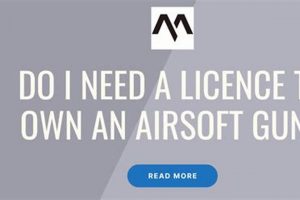
![Airsoft Legality: Risks of Orange Tip Removal [Guide] Ultimate Airsoft Guide for Beginners, Tactics & Gear Reviews Airsoft Legality: Risks of Orange Tip Removal [Guide] | Ultimate Airsoft Guide for Beginners, Tactics & Gear Reviews](https://airsoftica.com/wp-content/uploads/2025/10/th-990-300x200.jpg)
